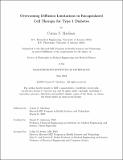Overcoming Diffusion Limitations in Encapsulated Cell Therapy for Type 1 Diabetes
Author(s)
MacIsaac, Corina N.
DownloadThesis PDF (13.24Mb)
Advisor
Anderson, Daniel G.
Terms of use
Metadata
Show full item recordAbstract
Type 1 diabetes is a life-threatening condition characterized by the body’s inability to produce sufficient insulin to properly regulate blood glucose levels. Despite advances in glucose monitoring/insulin delivery systems, the pancreatic islet is still functionally superior at regulating blood glucose levels. Pancreatic islet transplantation requires immune suppression, but islet encapsulation would eliminate this requirement. A hydrogel encapsulation barrier, made from alginate, physically shields transplanted cells from rejection by the immune system. However, encapsulated islets completely rely on diffusion for nutrient delivery which can be limited by the encapsulation material, the naturally large size of pancreatic islets, and the fibrosis around the capsules from the foreign body response.
In this thesis, we address these diffusion limitations to improve the long-term survival and function of encapsulated islets. First, we explore the use of peptide-modified alginates to improve the function of diffusion advantageous dissociated islets. Next, we analyze the potential benefit of increasing vascularization at the surface of the alginate capsule. Although the islet must remain avascular to be protected from the immune system, the diffusion analysis illustrates that vascularization at the capsule surface could increase oxygen delivery. This analysis motivated the engineering of an endothelial cord construct that promotes vascularization around the implanted capsules. We demonstrate that these engineered vascularized constructs result in a significant improvement in the curing of diabetes in mice. Altogether, this work addresses some of the diffusion limitations in cell encapsulation systems and results in the increased survival and function of encapsulated islets in vivo.
Date issued
2023-06Department
Harvard-MIT Program in Health Sciences and TechnologyPublisher
Massachusetts Institute of Technology